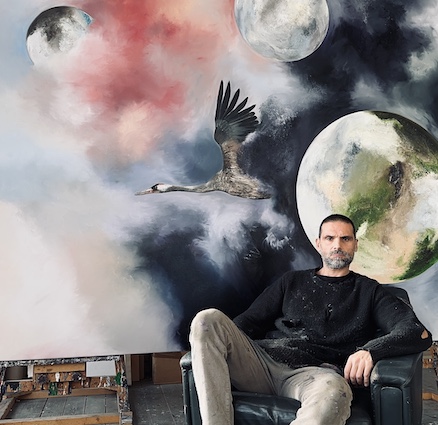biography

place of birth: palermo – italy
date of birth: 22.03.1972
place of residence: düsseldorf – germany
Interview 2024
Pietro Conti: “Art is often an incredibly brutal affair.”
Pietro Conti is an Italian painter and sculptor who lives and works in Düsseldorf. He painted his first works in his home town of Palermo, which he left at the age of 29 to study in Germany. From 2004 to 2006, he experimented with various painting techniques and found his style in abstract representation. Düsseldorf is a city overcrowded with artists because of the art academy and it is not easy to establish yourself as an artist here. Nevertheless, Pietro Conti created his own empire and has been painting obsessively ever since. His works are often huge, sometimes 2 to 3 metres high. After a rather gloomy phase 10 years ago, he now favours planetary landscapes, skies reminiscent of Italian ceiling paintings and enigmatic symbols. Other passions of the artist are literature and psychology. Accordingly, his works bear titles such as , divisione del tempo, il suono del tempo or manifesto del tempo.
“When I paint, the so-called I as Pietro is switched off. The work takes over and takes control of what is happening.”
Mr Conti, what is important to you in life?
My artistic development as a painter in terms of visual language and composition.
What is the role or task of an artist?
A continuous addiction and a great responsibility towards art and the corresponding confrontation with oneself as a painter and as a person. This is often an incredibly brutal affair.
Your surrealistic and colourful paintings are immediately recognisable as yours. Do you like having a signature?
I just follow my instinct as a painter.
What do you think when you paint.
It is very difficult to give a well-founded answer, but I try. Of course, the expression of my works corresponds to my philosophy of understanding art and realising it, but when I paint, the so-called I as Pietro is switched off. The work takes over and takes control of what is happening. My action loses its position as such. The different creative possibilities are relativised at the same time. At this moment, I have hardly any decision-making power. You have to experience it to understand it. Gerhard Richter once said the following in an interview: It is an intimate affair. Sometimes there is a kind of struggle between me and the work that I can’t understand. The interesting thing is that the work at the end corresponds exactly to my idea, which I couldn’t categorise beforehand.
“I was just following my instincts as a painter.”
You describe your working process as academic. Can you tell me what that means in concrete terms?
I believe that as a painter it is necessary to have a sound knowledge of the visual language in order to create good works of art. Although I have been rejected several times by the various German art academies, I have levelled this by studying contemporary art. As Friedrich Nietzsche said: One has to learn to see. It is the same in art, in my opinion. I have learnt to see and, of course, to put it into practice. I often went to lectures at the Düsseldorf Art Academy to learn how the whole thing works. At the same time, I studied different artists. Like Francis Bacon, Gerhard Richter, Jonas Burgert, Adrian Ghenie and the artists from the Leipzig School, Arno Rink and Neo Rauch. That is absolutely essential and fundamental to the creative process.
“The universe probably made sure that I came to Germany. I had to leave my comfort zone so that I could perhaps develop.”
How does an artist move from Palermo to Düsseldorf? Do you feel at home here as an Italian?
I think it was a question of fate. The universe probably made sure that I came to Germany. I had to leave my comfort zone so that I could perhaps develop. First as an artist and then as a person. That would be a plausible explanation. I am very impressed by the so-called welcoming mentality that prevails in Germany. I feel very much at home in Germany.
I am also very impressed by your library. What are your favourite books?
Thank you for the compliment. Apart from the various books on international painters, I don’t really have a favourite. I like the book “Scent of Time” by Byung-Chul Han or the book by Yuval Noah Harari “21 Lessons for the 21st Century.

